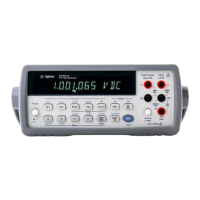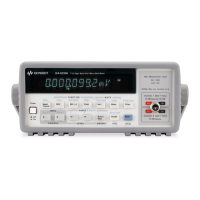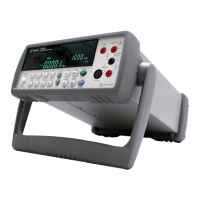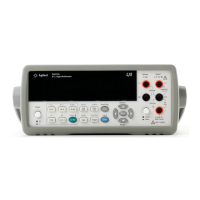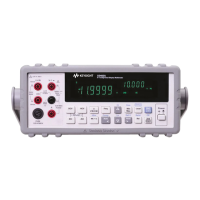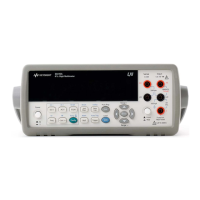Chapter 6 Command Reference 165
CALNUM?
Default name = 0.
Remarks • Subprograms are created with the SUB command.
• The multimeter sets bit 0 in the status register after executing a stored
subprogram.
• From the front panel, you can view all stored subprogram names by accessing
the CALL command and pressing the up or down arrow key. Once you have
found the correct subprogram, press the Enter key to execute the subprogram.
• Related Commands: COMPRESS, CONT, DELSUB, PAUSE, SCRATCH,
SUB, SUBEND
Examples OUTPUT 722;"CALL DCCUR2" !EXECUTES SUBPROGRAM NAMED "DCCUR2"
CALNUM?
Calibration Number Query. Returns an integer indicating the number of times
the multimeter has been calibrated.
Syntax CALNUM?
Remarks • The calibration number is incremented by 1 whenever the multimeter is
calibrated. If autocal is secured, the calibration number is also incremented by
1 whenever an autocal is performed; if unsecured, autocal does not affect the
calibration number.
• The calibration number is stored in cal-protected memory and is not lost when
power is removed.
• The multimeter was calibrated before it left the factory. When you receive the
multimeter, read the calibration number to determine its initial value.
• Related Commands: CAL, CALSTR, SCAL
Example 10 OUTPUT 722;"CALNUM?" !READS CALIBRATION NUMBER
20 ENTER 722;A !ENTERS RESPONSE INTO COMPUTER
30 PRINT A !PRINTS RESPONSE
40 END
CALSTR
Calibration String (remote only). Stores a string in the multimeter's nonvolatile
calibration RAM. Typical uses for this string include the multimeter's internal
temperature at the time of calibration (TEMP? command), date of calibration,
technician's name, and the scheduled date for the next calibration.

